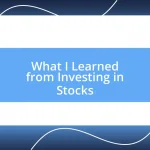Key takeaways:
- Understanding that stock market fluctuations are influenced by economic indicators, investor sentiment, and global events can help investors navigate uncertainty and identify opportunities.
- Diversification and a long-term perspective are crucial strategies for managing risk during market volatility, allowing investors to stay focused on their overall investment goals.
- Market downturns provide valuable lessons in emotional regulation and preparation, reinforcing the cyclical nature of investing and the importance of seeing challenges as opportunities for growth.

Understanding stock market fluctuations
Stock market fluctuations are often a source of confusion and anxiety for many investors. I remember my first encounter with a significant dip; my heart raced as I watched the numbers drop. It made me wonder—how could something I believed in so strongly change so quickly?
These fluctuations are not random whims of the market; they’re influenced by a plethora of factors, including economic indicators and investor sentiment. I often feel that during a market downturn, it’s easy to let fear take over. Yet, reflecting on my experiences, it’s crucial to understand that these waves are part of a larger cycle.
When I think back to moments of uncertainty, I remind myself that volatility can also present opportunities. Have you ever considered how a downturn might open doors for strategic investments? Embracing this perspective has often helped me navigate the emotional rollercoaster that comes with watching the market’s ebb and flow.

My initial investment journey
I embarked on my investment journey with a mix of excitement and trepidation. It was exhilarating to take my first steps into the stock market, but I quickly realized that it was not a straightforward path. I vividly remember the moment I made my very first investment; I felt a rush of adrenaline as I clicked that “buy” button, but my initial thrill quickly gave way to anxiety as I watched the market fluctuate in the days that followed.
- I chose to invest in a tech company I believed had strong growth potential.
- As the stocks soared, I experienced a euphoric sense of validation in my choices.
- However, when the market dipped shortly after, I wrestled with self-doubt about my decision-making abilities.
With every fluctuation, I learned valuable lessons about patience and strategy. Those early days were like a rollercoaster ride, packed with sharp turns and unexpected drops, but they helped me shape my approach to investing. I’ve come to understand that each dip and peak is a chance not just to reassess my investments but also to grow as a more resilient investor.

Key factors affecting stock prices
Several key factors significantly influence stock prices, and I’ve found that keeping these in mind can help guide my investment decisions. One major factor is corporate earnings reports. When a company reports earnings that exceed expectations, I often see its stock price surge. Conversely, disappointing earnings can lead to sharp declines, as I learned when I held stocks in a company that missed its quarterly targets. The disappointment was palpable—not just for the company, but also for my portfolio.
Another critical element is market sentiment. I remember during a recent recession how investor confidence waned, leading to widespread selling. It’s fascinating to see how emotions can drive the market. In my experience, understanding this emotional landscape can provide a competitive edge. For example, during the COVID-19 pandemic, I noticed how a glimmer of positive news could trigger a significant rally. It really emphasized for me how interconnected emotions and market movements are.
Lastly, global events—such as political changes or natural disasters—can also sway stock prices dramatically. I recall the market’s response to a major geopolitical event a couple of years ago; stocks plummeted overnight. I had to remind myself that while these external factors may be out of my control, my reaction to them is not. When the market is affected by uncertainties, staying informed and level-headed becomes essential.
| Factor | Description |
|---|---|
| Corporate Earnings | Stock prices react strongly to a company’s quarterly earnings reports. |
| Market Sentiment | Investor emotions and confidence significantly impact stock movements. |
| Global Events | Natural disasters or political events can lead to sudden price changes. |

Strategies for navigating market volatility
Having navigated through the waves of market fluctuations, I’ve found a few strategies that truly help me stay afloat during turbulent times. One approach I rely on is diversification. By spreading my investments across various sectors and asset classes, I can mitigate the impact of a single market downturn. I vividly recall a time when tech stocks nosedived, but my healthcare and energy investments held steady, allowing me to breathe a little easier. Have you ever thought about how diversification could be a safety net for your portfolio?
Another strategy that has served me well is maintaining a long-term perspective. In times of volatility, I remind myself that the market has historically rebounded. There was a particularly anxious period when I grappled with the temptation to sell during a downturn; however, leaning on my investment thesis kept me focused on the bigger picture. It’s fascinating how a shift in mindset can alter your actions—have you ever considered how patience might be your strongest ally when the market roils?
Finally, I make it a point to stay educated about current events and trends. By reading articles and connecting with fellow investors, I can gauge how external factors may influence my portfolio. I distinctly remember a pivotal moment during an earnings season when I tuned into an analyst call that changed my outlook on my investments. Their insights not only informed my decisions but also eased my anxiety. Isn’t it empowering to know that getting informed can help transform uncertainty into strategic advantage?

Lessons learned from market drops
Market drops can be tough, but I’ve found those downturns often offer valuable lessons. I remember when the market took a nosedive during my early investing days; I felt a surge of panic creeping in. It was then that I realized how crucial it is to keep emotions in check. Reacting impulsively can lead to hasty decisions, often at the worst possible time. Have you experienced that moment when your gut feelings clash with rational thought? Learning to breathe and assess the situation helped me become a more grounded investor.
Another important lesson I learned is the significance of preparation. During one substantial drop, I had to face my fears head-on. I’d spent time building an investment plan, complete with an emergency fund and a clear understanding of my risk tolerance. When the market tumbles, fear often takes over, but knowing I had a strategy in place gave me the confidence to weather the storm. Isn’t it reassuring to think that being prepared can turn chaos into manageable challenges?
Lastly, I’ve discovered that every market drop can serve as a reminder of the cyclical nature of investing. I vividly recall a downturn that wiped out a significant portion of my portfolio. At first, it felt like a gut punch, but reflecting on past recoveries offered a sense of hope. I began to ask myself, “What opportunities might arise from this drop?” Shifting my perspective from despair to opportunity allowed me to see potential bargains in the market, fostering a mindset geared towards growth rather than defeat. Isn’t it fascinating how shifting our outlook can transform our experience during tough times?

Long-term vs short-term investing
When it comes to investing, I often wrestle with the age-old debate of long-term versus short-term strategies. From my experience, short-term investing can feel exhilarating, like a roller coaster ride where every bump and dip raises your adrenaline levels. However, more often than not, I find that chasing quick profits can lead to unnecessary stress and rash decisions. Have you ever felt that urgency in trying to capitalize on market fluctuations, only to realize it may not align with your true financial goals?
On the other hand, I’ve truly grown to appreciate the benefits of long-term investing. Sticking to a well-crafted investment plan often feels like planting a seed; it requires patience, nurturing, and a bit of faith. I recall a period where I chose to hold onto a few undervalued stocks despite market noise. Watching those investments flourish over the years reinforced my belief that sticking to the fundamentals pays off. How often do we overlook the power of time in growing our wealth?
I remember having a conversation with a fellow investor who was adamant about short-term trades, believing they possessed the key to instant wealth. Listening to him, I couldn’t help but reflect on my own journey, where I’d seen countless others burn out from the volatility of such a strategy. It made me think: Is it worth sacrificing stability and peace of mind for the thrill of quick gains? Ultimately, my experience has taught me that striking a balance between the two approaches is key, but a long-term vision truly anchors me amidst market fluctuations.

Future outlook for stock markets
I’ve been pondering the future outlook for stock markets lately and it’s intriguing to see how many factors play into this ever-evolving landscape. With ongoing advancements in technology and the rise of retail investors, the dynamics are shifting. It reminds me of my early days, watching trends change so quickly; I often felt like I was playing catch-up. Are we on the brink of another transformation in how we engage with the market?
Looking ahead, I sense a mix of both promise and uncertainty. For instance, the potential impact of economic policies and global events can swing market sentiments dramatically. I once entered a trade just before a major announcement, and you could practically feel the tension in the air. The outcome left me questioning my timing and strategy. Have you ever ridden that wave, only to watch your plans go awry at the very last minute?
The incorporation of sustainable investing trends also fascinates me. As more investors prioritize environmental, social, and governance (ESG) factors, I can’t help but wonder how this will reshape the market. I recall investing in a green energy firm that, at first, felt like a gamble. However, as societal values shifted, it blossomed into a strong performer. Isn’t it amazing how aligning investments with our values can lead to both personal satisfaction and financial success? The future may very well hinge on our collective choices today.














